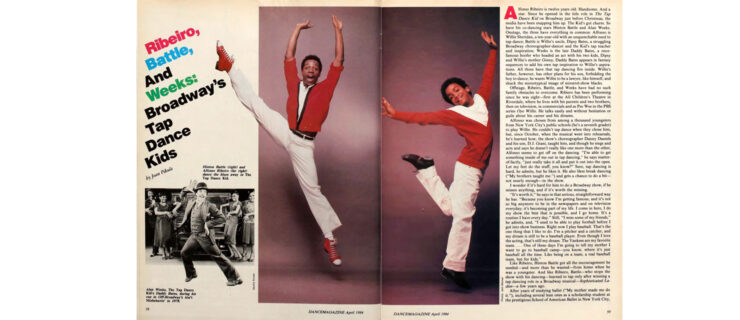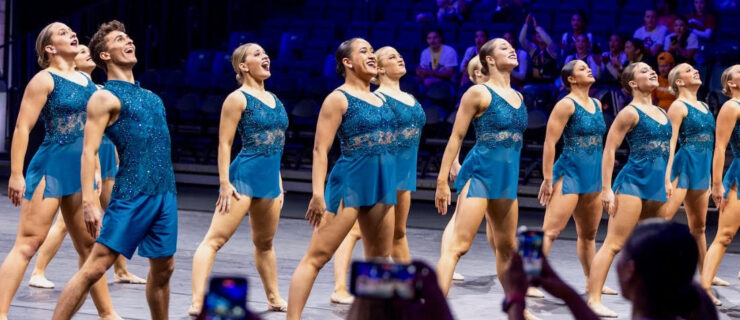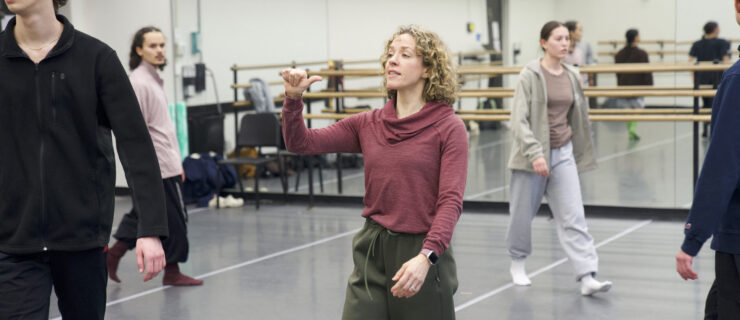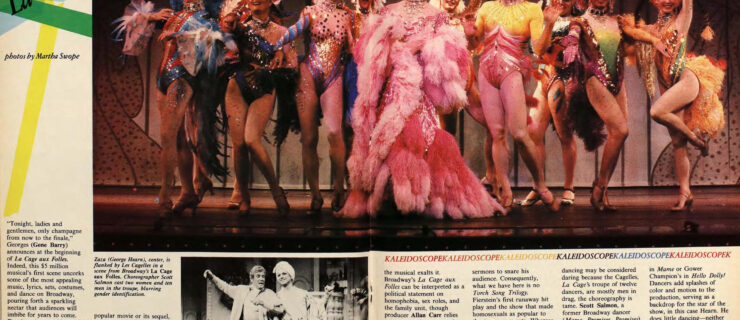Fresh Start
Rie Ichikawa, Lia Cirio, Whitney Jensen, and Pavel Gurevich in
Apollo. Photo by Gene Schiavone, Courtesy BB, © The Balanchine Trust.
The September 2009 move to the Boston Opera House was a miracle of timing for Boston Ballet, positioning the company directly at the center of the city’s newest downtown entertainment area. With the nearby renovated Paramount Theatre’s cutting edge performance series starting this fall, the corner of Washington and Tremont Streets has transformed from an edgy neighborhood after dark to one that’s alive with trendy restaurants and the twin lighted marquees.
Boston Ballet left its longtime former home at the Wang Center for the Performing Arts (now the Citi Performing Arts Center) when the relationship became increasingly fraught. The Wang expelled The Nutcracker in favor of The Radio City Christmas Spectacular in 2004, putting the ballet company in financial jeopardy. Happily, Boston Ballet has made payments to reduce past debts and closed its most recent season in the black. The dancers are performing with renewed vigor, a combination of risk-taking by the younger dancers and nuanced performances by the more experienced ones, as if to celebrate the company’s rising fortunes.
The larger stage of the Wang Theatre, which seats 3,600, suited the company’s productions of 19th-century spectaculars, but contemporary ballets often looked lost in the shadows of the huge space. The Opera House, built in 1928 to house vaudeville as well as movies, holds 2,600 viewers in a more intimate relationship to the stage.
“After our first season we are thrilled,” says artistic director Mikko Nissinen. “The Opera House is a much better experience for our audiences.” Principal dancer Lorna Feijóo comments, “The Opera House is beautiful and it has a good stage. It’s smaller but warm in that we’re closer to our audiences.”
Music director and principal conductor Jonathan McPhee believes that the Opera House acoustics are second only to Boston’s Symphony Hall. “What the critics and the audiences noticed this year was live musicians and dancers working together,” he says.

The company was flying high at the close of the first Opera House season—and not just because the dancers were off to Spain for a summer tour. A sold-out house for the company’s fall benefit, “Night of Stars,” had kicked off the 46th season, and its beloved, monthlong production of The Nutcracker attracted 70,000 fans, amid a frenzy of ticket-scalping. Then in April the company premiere of the Balanchine-Danilova Coppélia had the town buzzing, making a ticket to the ballet nearly as hot a prize as admission to a Red Sox game.
The season ended with two weekends of an impeccably performed triple bill of Balanchine works, and a repeat of the 2009 Kylián evening. The previous year’s surprise sell-out of Kylián’s hard-edged, contemporary works had lured new viewers from the much desired 18-to-35 age pool. The “rebranding” of the company has included a lively series of blogs written by the dancers on the vibrant new website.
Nissinen’s vision starts with a repertory he calls “inclusive, not exclusive.” He talks about the three doors: The first is the classical, 19th-century repertory; next, contemporary and neoclassical ballet; and finally, Balanchine. His determination to place the company solidly in the Balanchine tradition refers back to his decade as a principal dancer with San Francisco Ballet, where he performed in many of the choreographer’s works. The staging of these ballets circles the company back to founder E. Virginia Williams’ close association with Balanchine, who recommended her fledgling troupe for several of the early Ford Foundation grants to establish the company. Nissinen has appointed Russell Kaiser as the company’s assistant artistic director, and Margaret Tracey as director of the Boston Ballet School. The Balanchine-steeped husband-and-wife team are former dancers with the New York City Ballet.
The programming for 2010–11 reflects Nissinen’s direction for the company. After this month’s “Night of Stars,” the season begins in November with a revival of La Bayadère, continues with The Nutcracker, of course, but then veers into modern times with a March/April evening that includes a world premiere by Jorma Elo, the company’s resident choreographer. Elo’s high-energy, athletically challenging works have enhanced the strengths of the dancers he has come to know so well. More Balanchine is on the schedule with his A Midsummer Night’s Dream in April, followed by a late April/early May bill of Kylián’s Bella Figura, Forsythe’s The Second Detail, and Helen Pickett’s (Arvo) Pärt I, II, and III. A Balanchine/Robbins mixed program ends the season, May 12–22.
But the pillars to support Nissinen’s vision are the 46 dancers of the main troupe and 11 members of the second company. Some of these have been nurtured through the ranks to principal dancers, such as the luscious Kathleen Breen Combes, along with Pavel Gurevich, Misa Kuranaga, and James Whiteside. Gurevich, formerly of the Bolshoi Ballet of Belarus, is a high jumper, but can look sinuous in roles like Arabian in The Nutcracker, and vulnerable yet emphatic as Balanchine’s Apollo. Whiteside, recently declared “the company’s outstanding male dancer” by The New York Times’ critic Alastair Macaulay, is elegant onstage and an excellent partner.
Combes, who was married this past summer to principal dancer Yury Yanowsky, talked about the camaraderie that develops in a tightly bound, hard-working troupe, locked together in the studio by day and the theater at night. “I came in 2003, starting in the corps de ballet. But with Mikko, even in the corps you have opportunities. The first thing was my casting as lead bridesmaid in Don Quixote. I was shocked. It’s also a nice thing to grow up with the other dancers. Misa and I came into the company at the same time and were promoted together.”
The long-legged, charismatic Combes burst on the public consciousness when she appeared on the cover of Dance Magazine in October 2007. But it was her sparkling performance as the solo girl in “Rubies,” at the 2009 company premiere of Balanchine’s Jewels, that assured her recent promotion. Kuranaga, of the doll-like features, mischievous manner, and technique forged of steel, made a Swanilda to remember.
Along with shaping talent from within, Nissinen is continually looking out for the very young. In a fortuitous hiring last season, he snared 17-year-old Whitney Jensen, who landed on the cover of Dance Magazine as a “25 to Watch” in January. She’s now 18, has been promoted to second soloist, and has been cast already in featured roles. Also promoted to second soloist is Jeffrey Cirio, another teenager to watch. His sister, Lia Cirio, who blazed across the stage as Terpsichore in Balanchine’s Apollo and made a heart-breaking Micaela in Elo’s Carmen, has been promoted to principal dancer. A new principal dancer, Lasha Khozashvili, from State Ballet of Georgia, joins this season, as does the technical dynamo Joseph Gatti, lured from Corella Ballet, as soloist.
But Nissinen has not neglected longtime company principals. These include: Larissa Ponomarenko; Yanowsky, now in his 18th year; and Lorna Feijóo and her husband, Nelson Madrigal, both Cubans who came to Boston eight years ago. Feijóo commented on the international lineup in the company and the youth of its dancers. “It’s great when you can see young people and maturity—a complete company with everything. It’s important for young people to have role models.” Feijóo and Madrigal will be joined by more Cuban dancers this coming season—and Nissinen has asked Feijóo to coach them.
When Virginia Williams launched the first season of a professional ballet company in 1964 on the rocky shores of Boston Harbor, few people would have bet on its future. However, Nissinen, backed by his executive director, Barry Hughson, and an enthusiastic board of directors, are looking ahead to Boston Ballet’s 50th birthday celebration in 2013–2014. With plans underway for a new production of Swan Lake, and repertory set for the years in between, Nissinen vows, “We’ll do better and better.”
Iris Fanger, former director of the Harvard Summer School Dance Center, is a Boston-based dance and theater critic.




